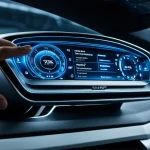Latest Safety Innovations in UK Automotive Industry
In recent years, UK car safety innovations have surged, reflecting significant progress in advanced vehicle safety features and UK automotive technology. UK manufacturers are adopting cutting-edge solutions to enhance driver and passenger protection, focusing on reducing accident rates and improving overall road safety.
A prime example is the introduction of advanced driver assistance systems (ADAS), which encompass technologies such as adaptive cruise control, lane-keeping assist, and automatic emergency braking. These systems actively support drivers by detecting hazards and intervening to avoid collisions or mitigate their impact.
Also read : The Evolution of the UK Automotive Industry: What Are the Key Challenges Faced Today?
Moreover, UK brands utilize sensors, cameras, and radar technology to create comprehensive safety ecosystems within vehicles. This integration enables better situational awareness and quicker response times, substantially enhancing accident prevention capabilities.
Beyond traditional features, UK automotive technology now includes AI-based systems that learn driver behavior and environmental conditions. This dynamic approach allows safety mechanisms to adapt and anticipate potential risks more accurately.
Also to see : What Are the Emerging Technologies Defining the Future of UK Automotive Industry?
Altogether, these innovations demonstrate a clear commitment within the UK automotive sector to pushing vehicle safety forward. By embedding advanced vehicle safety features and pioneering technologies, UK car safety innovations are setting new standards in accident prevention and occupant protection.
Brand-Specific Safety Enhancements
UK car safety innovations have become increasingly brand-tailored, with manufacturers like Jaguar, Land Rover, and MINI integrating unique advanced vehicle safety features into their models. Jaguar stands out for its use of AI-driven safety systems. These systems analyze vast amounts of data from sensors and cameras in real time, enabling the vehicle to predict hazards and react swiftly. This application of UK automotive technology elevates driver and passenger protection by anticipating dangerous situations before they fully develop.
Land Rover focuses on combining off-road capability with occupant safety. Its latest safety upgrades include robust structural design, terrain-response adaptations, and enhanced airbags to safeguard passengers during both on-road and off-road conditions. Land Rover’s continuous evolution demonstrates how UK car safety innovations can be specialized to meet the demands of diverse driving environments while maintaining strict safety standards.
MINI has invested heavily in safety technology tailored specifically for compact cars. Recognizing the challenges of protecting occupants in smaller vehicles, MINI employs advanced crash avoidance systems and reinforced cabin structures. These features underscore the importance of precise engineering within the scope of advanced vehicle safety features in smaller segments of the market.
Collectively, these brands illustrate the depth and adaptability of UK automotive technology in addressing different safety needs. Each manufacturer deploys distinct approaches yet shares a common goal—to advance vehicle safety through innovation tailored to their unique product lines. This strategy enhances accident prevention and occupant protection, reinforcing the UK’s position as a leader in automotive safety innovation.
Collaboration and Industry Partnerships
Collaboration plays a pivotal role in advancing UK automotive technology and accelerating UK car safety innovations. Leading manufacturers actively engage in automotive industry partnerships to develop pioneering advanced vehicle safety features. Such joint efforts combine expertise across engineering firms, technology developers, and academic institutions to foster breakthroughs beyond what individual companies might achieve alone.
One key form of collaboration involves partnerships between carmakers and universities or specialized research centres within the UK. These collaborations enable cutting-edge studies on sensor technology, AI algorithms, and real-world data analysis, which directly contribute to refining safety systems. For instance, real-time hazard detection and adaptive responsiveness in vehicles benefit greatly from this synergy between theory and practical application.
Cross-industry alliances also speed up the deployment of new safety technologies. By partnering with software companies, hardware suppliers, and regulatory bodies, automotive firms create dynamic ecosystems where innovative advanced vehicle safety features evolve more rapidly. This integration ensures that safety improvements are thoroughly tested and standardized while moving swiftly from lab prototypes to commercial vehicles.
Overall, these automotive industry partnerships enhance the capability of UK brands to pioneer safer vehicles. By pooling resources and expertise, the sector sustains its leadership in developing UK car safety innovations tailored for modern road conditions and evolving regulatory landscapes.
Regulatory Compliance and Safety Standards
UK car safety innovations are strongly influenced by UK vehicle regulations and evolving automotive safety standards. Compliance with these regulations is not merely a legal obligation but a driving force for manufacturers to integrate advanced vehicle safety features that meet or surpass required criteria. The UK adheres to stringent safety regulations aligned with both domestic and EU frameworks, ensuring that new vehicles undergo rigorous testing for crashworthiness, pedestrian protection, and electronic safety systems before market entry.
How do brands ensure compliance in car manufacturing? They implement comprehensive safety validation processes, which include simulations, physical crash tests, and real-world performance assessments. These steps guarantee that vehicles’ structural integrity and UK automotive technology—such as airbags, electronic stability control, and ADAS—function as intended under diverse conditions, thereby safeguarding occupants and other road users.
Regulatory changes also stimulate innovation by setting higher safety benchmarks. For example, recent mandates on driver assistance and collision avoidance systems have accelerated the adoption of AI-powered features and sensor integration. This regulatory environment compels UK manufacturers to continuously evolve their safety technologies, ensuring that UK car safety innovations remain at the forefront of global standards, contributing to safer roads both nationally and internationally.
Future Trends and Emerging Technologies in Vehicle Safety
The horizon of future car safety trends in the UK automotive sector is dominated by advances in autonomous driving safety and enhanced connectivity. Innovations focus on integrating emerging vehicle safety technology like vehicle-to-everything (V2X) communication, which allows cars to interact with other vehicles, infrastructure, and pedestrians in real time. This connectivity significantly improves hazard detection and response times, reducing accidents before they occur.
Experts anticipate that the evolution of automotive innovation will prioritize fully autonomous vehicles equipped with sophisticated sensor arrays and AI systems. These systems not only understand immediate surroundings but also predict potential risks by analyzing complex traffic scenarios. As a result, vehicles will undertake proactive safety measures, providing a higher level of accident prevention unattainable by human drivers alone.
Additionally, the fusion of UK automotive technology with cloud computing and big data analytics will enable continuous learning and improvement of safety features. Real-world driving data will be harnessed to calibrate autonomous algorithms dynamically, ensuring that future car safety trends remain adaptive to diverse road conditions and emerging threats. This approach promises a transformative leap forward, making roads safer through intelligent, connected, and anticipatory vehicle systems.






